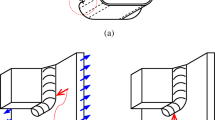Abstract
We report an optimization procedure of automobile steel wheel fatigue life enhancement considering multi axial stresses based on critical plane approach via Design of experiments (DOE), Response surface methodology (RSM) and reflective Newton methodology. The wheel disc stiffener shape was optimized by defining seven parameters of the stiffener shape (design factors). Central composite design of experiments theory was used to select a minimum but sufficient combination of the design factors, FEM analysis was used to compute the stresses in the disc wheel under cornering load for each design factor combination. To verify the FEM modeling, we conducted an experimental fatigue test. The stress components variation for any arbitrary direction of loading were estimated and the multi axial fatigue and critical plane approach were used to evaluate the margin to fatigue damage. We found that stress components for only three radial loading directions of the rotating force are required to obtain sufficiently accurate stress histories at critical point and critical direction. A clear method was introduced regarding the correct shear stress range selection on critical plane. The RSM, a quadratic surface, was fitted to analytical results regarding the mentioned models. To verify the accuracy of the fitted surface, the responses at the design factors combinations were calculated via the identified quadratic model and compared to the FEM analysis results. Optimum value of design factors was obtained through reflective Newton method which led to generation of the refined wheel stiffener shape. The proposed method for determining the stress components could be used in any similar rotating parts such as wheel hub, brake disc, brake drum, etc.
Similar content being viewed by others
References
Y. L. Hsu, C. C. Yu, S. C. Wu and M. H. Hsu, Developing an automated design modification system for aluminum disc wheels, J. of Engineering Manufacture, 221 (2007) 447–456.
H. Akbulut, On optimization of a car rim using _finite element method, Finite Elements in Analysis and Design, 39 (2003) 433–443.
M. S. Hsu and L. H. Hsu, Weight reduction of aluminum disc wheels under fatigue constraints using a sequential neural network approximation method, Computers in Industry, 46 (2001) 167–179.
L. Wang, Y. Chen, C. Wang and Q. Wang, Fatigue life analysis of aluminum wheels by simulation of rotary fatigue test, J. of Mechanical Engineering, 57 (2011) 1, 31–39.
Y. Abe, K. Mori and O. Ebihara, Optimization of the distribution of wall thickness in the multistage sheet metal forming of wheel disks, J. of Material Processing Technology, 125-126 (2002) 792–797.
M. M. Topaç, S. Ercan and N. S. Kuralay, Fatigue life prediction of a heavy vehicle steel wheel under radial loads by using finite element analysis, Engineering Failure Analysis, 20 (2012) 67–79.
C. Schäfer and E. Finke, Shape optimization by design of experiments and finite element methods-an application of steel wheels, Struct Multidisc Optim, 36 (2008) 477–491.
D. Xiao et al., Novel steel wheel design based on multiobjective topology optimization, J. of Mechanical Science and Technology, 28 (3) (2014) 1007–1016, DOI 10.1007/s12206-013-1174-8.
M. Firat et al., Numerical modeling and simulation of wheel radial fatigue tests, Engineering Failure Analysis, 16 (2009) 1533–1541.
X. Wang and X. Zhang, Simulation of dynamic cornering fatigue test of a steel passenger car wheel, International J. of Fatigue, 32 (2010) 434–442.
Z. Zheng et al., Numerical simulation of steel wheel dynamic cornering fatigue test, Engineering Failure Analysis, 39 (2014) 124–134.
S. M. Chen, D. F. Wang and J. M. Zan, Brake judder analysis using a car rigid-flexible coupling model, J. of Automobile Engineering, 226 (2012) 348–361.
D. C. Montgomery, Design and Analysis of Experiments, 3rd Ed., New York: Wiley (1991).
R. L. Mason, R. F. Gunst and J. L. Hess, Statistical Design and Analysis of Experiments with Applications to engineering and Science 2003, Wiley, ANSYS Theory Reference.
SAE J328 Revised 1994, Wheels-Passenger car and truck performance requirements and test procedures.
ANSYS Theory Reference, ANSYS Release 14.0.0, ANSYS, Inc. (2011).
Y. Liu and S. Mahadevan, Multiaxial high-cycle fatigue criterion and life prediction for metals, International J. of Fatigue, 27 (2005) 790–800.
G. Sines, Behaviour of metals under complex stresses, Sines G, Waisman JL (Eds.), Metal Fatigue, New York: McGraw-Hill (1959) 145–169.
J. Smith, Effect of range of stress on fatigue strength of metals, Univ. Illinois, Eng Exp Station, Bull No. 334 (1942).
P. Davoli et al., Papadopoulos IV. Independence of the torsional fatigue limit upon a mean shear stress, Int. J. Fatigue, 25 (6) (2003) 471–480.
T. F. Coleman and Y. Li, A reflective newton method for minimizing a quadratic function subject to bounds on some of the variables, Computer Science Department and Advanced Computing Research Institute, Cornell University, Ithaca, New York 14853, December 7 (1992).
Author information
Authors and Affiliations
Corresponding author
Additional information
Recommended by Associate Editor Jeong Sam Han
Homayoon Hamidian received his B.Sc. in Mechanical Engineering from Azad University of Tehran, in 2013, Iran. He specializes in finite element analysis, simulation and also so is interested in fracture mechanics and mechanical design and modeling.
Abdollah Tavakoli Lahijani received his B.Sc. and M.Sc. in Mechanical Engineering from Sharif University of Technology, Iran, in 2001 and 2003 and his Ph.D. 2017 from Iran University of Science & Technology, Iran. His main research interests are in vehicle design, engineering and manufacturing. He is currently the deputy of vehicle engineering and design in Automotive Research and Innovation center of SAIPA.
Shahram Shahriari received his B.Sc. and M.Sc. in Mechanical Engineering from Sharif University of Technology in, Iran, in 1993 and 1998, and his Ph.D. in Mechanical Engineering in 2011 from Tarbiat Modares University, Iran. His main research interests are in optimization, Simulation, vehicle dynamics, vehicle engineering. He is currently in charge of chassis system design in Automotive Research and Innovation center of SAIPA.
Rights and permissions
About this article
Cite this article
Hamidian, H., Lahijani, A.T. & Shahriari, S. Fatigue life enhancement of automobile wheel disc considering multi-axial stresses based on critical plane approach. J Mech Sci Technol 31, 2883–2892 (2017). https://doi.org/10.1007/s12206-017-0531-4
Received:
Revised:
Accepted:
Published:
Issue Date:
DOI: https://doi.org/10.1007/s12206-017-0531-4




